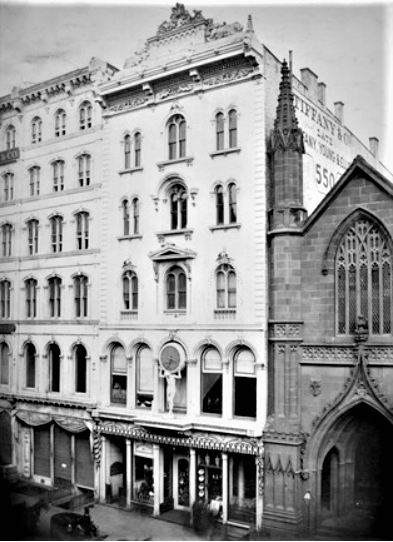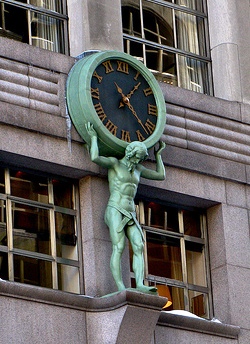This month, we explore the history of a local building once home to one of the most renowned luxury brands in the world. 550 Broadway was completed in 1854 and designed by architect R.G. Hatfield in a 5-story Italianate style featuring a white marble facade. In 1901, the building’s facade was changed to cast-iron. The building was first home to Tiffany & Co., then an emerging titan in the American jewelry industry capitalizing on the demand for sterling silver jewelry, home objects, and accessories. During this time, Tiffany & Co. was expanding on the success of the Tiffany Blue Book, the first direct-mail catalogue in the U.S.

Photo: Daytonian in Manhattan
Charles Tiffany, founder of Tiffany & Co., commissioned Henry Frederick Metzler to sculpt a 9-foot figure of the Greek God Atlas shouldering a 4-foot clock to mark the entrance of the new building. Tiffany commissioned the sculpture to enhance the facade at 550 Broadway, reportedly feeling the facade was “monotonous.”

Photo: Daytonian in Manhattan
Atlas and the Tiffany clock are representative of great artistic and architectural vision. Additionally, the Tiffany clock served an everyday, quotidian purpose as one of the first public clocks in New York City. Similarly, the cast-iron buildings that have become synonymous with the SoHo neighborhood were the result of a popular architectural style for both its aesthetic characteristics and building practicality.
Since making its debut on 550 Broadway, Atlas and the Tiffany clock have moved to several different locations, including Union Square in the 1870s before eventually securing their iconic flagship location on Fifth Avenue and Fifty-seventh Street in 1940. Although Tiffany & Co. eventually carried their business elsewhere, the years spent at 550 Broadway laid the foundation for its continued success.
A New York Times article remarks,
“Atlas and the clock have been identified with Tiffany & Co. since 1853, when the business was carried on at 550 Broadway.”
The New York Times
In August 1973, 550 Broadway was included in the SoHo-Cast Iron Historic District designated by New York City Landmarks Preservation Commission, protecting this notable building for posterity.